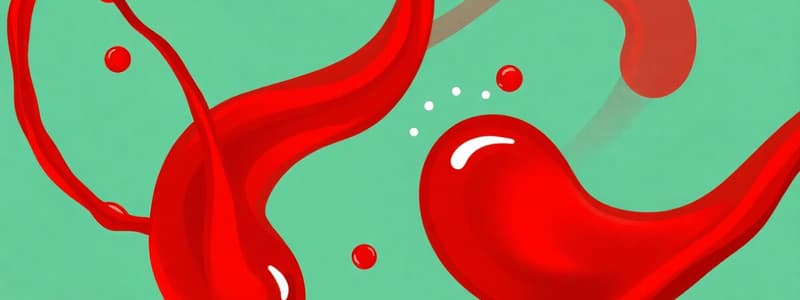Podcast
Questions and Answers
What is the normal range for blood glucose levels?
What is the normal range for blood glucose levels?
- 80-120 mg% (correct)
- 140-180 mg%
- 200-250 mg%
- 50-70 mg%
Extreme hypoglycemia can lead to unconsciousness.
Extreme hypoglycemia can lead to unconsciousness.
True (A)
What is the term for the synthesis of glycogen from glucose?
What is the term for the synthesis of glycogen from glucose?
Glycogenesis
Glycolysis consists of three stages: Primary stage, Splitting stage, and ________ stage.
Glycolysis consists of three stages: Primary stage, Splitting stage, and ________ stage.
Match the following processes with their definitions:
Match the following processes with their definitions:
Which enzyme is primarily responsible for phosphorylating glucose in liver cells?
Which enzyme is primarily responsible for phosphorylating glucose in liver cells?
Hexokinase is inhibited by glucose-6-phosphate.
Hexokinase is inhibited by glucose-6-phosphate.
What substance is formed from fructose-6-phosphate by phosphofructokinase?
What substance is formed from fructose-6-phosphate by phosphofructokinase?
The reaction catalyzed by aldolase splits Fructose-1,6-bisphosphate into ________ and Glyceraldehyde 3-phosphate.
The reaction catalyzed by aldolase splits Fructose-1,6-bisphosphate into ________ and Glyceraldehyde 3-phosphate.
Match the enzyme with its function:
Match the enzyme with its function:
Flashcards
Hexokinase
Hexokinase
Enzyme that phosphorylates glucose using ATP, making it irreversible, found in all tissues
Glucokinase
Glucokinase
Enzyme that phosphorylates glucose in liver cells; its activity isn't affected by glucose concentration and is affected by insulin and diabetes
Hexokinase vs. Glucokinase
Hexokinase vs. Glucokinase
Different glucose phosphorylation enzymes; Hexokinase is found in all tissues, inhibited by glucose-6-phosphate; Glucokinase is in liver, not inhibited by glucose-6-phosphate but affected by insulin and diabetes
Phosphofructokinase-1 (PFK-1)
Phosphofructokinase-1 (PFK-1)
Signup and view all the flashcards
Fructose-2,6-bisphosphate
Fructose-2,6-bisphosphate
Signup and view all the flashcards
Glycolysis
Glycolysis
Signup and view all the flashcards
Rate-limiting Enzyme
Rate-limiting Enzyme
Signup and view all the flashcards
Irreversible Reaction
Irreversible Reaction
Signup and view all the flashcards
Feedback Inhibition
Feedback Inhibition
Signup and view all the flashcards
Blood Glucose
Blood Glucose
Signup and view all the flashcards
Normal Blood Glucose Level
Normal Blood Glucose Level
Signup and view all the flashcards
Hypoglycemia
Hypoglycemia
Signup and view all the flashcards
Hyperglycemia
Hyperglycemia
Signup and view all the flashcards
Extreme Hypoglycemia
Extreme Hypoglycemia
Signup and view all the flashcards
Extreme Hyperglycemia
Extreme Hyperglycemia
Signup and view all the flashcards
Renal Threshold
Renal Threshold
Signup and view all the flashcards
Glycogenesis
Glycogenesis
Signup and view all the flashcards
Glycogenolysis
Glycogenolysis
Signup and view all the flashcards
Gluconeogenesis
Gluconeogenesis
Signup and view all the flashcards
Glycolysis
Glycolysis
Signup and view all the flashcards
Aerobic Respiration
Aerobic Respiration
Signup and view all the flashcards
Anaerobic Respiration
Anaerobic Respiration
Signup and view all the flashcards
Hexokinase
Hexokinase
Signup and view all the flashcards
Glucose-6-Phosphate
Glucose-6-Phosphate
Signup and view all the flashcards
Study Notes
Blood Glucose
- Blood sugar level is the concentration of glucose in blood.
- Normal blood glucose levels are 80-120 mg % (per 100 ml blood or/dL).
- Low blood glucose is called hypoglycemia.
- High blood glucose is called hyperglycemia.
Extreme Hypoglycemia
- Caused by excess insulin.
- Leads to unconsciousness and death.
- The brain depends on glucose for energy.
- The brain cannot store glucose.
Extreme Hyperglycemia
- Caused by a lack of insulin.
- Renal threshold is over 180 mg%.
- Normal renal threshold is 180 mg%.
- Glucose appears in the urine.
Control of Blood Glucose
- Synthesis and breakdown of glycogen are key processes.
- Key hormones controlling blood glucose levels:
- Insulin
- Glucagon
- Adrenaline
Glycolysis
- Occurs in all human cells.
- Glucose breaks down into two 3-carbon atoms compounds called pyruvate.
- A small amount of energy is produced and stored as ATP.
- The fate of pyruvate acid produced depends on the organism's metabolic status.
Anaerobic Conditions
- Pyruvate converts into waste products like lactate, ethanol, and acetic acid.
- Oxygen is absent.
Aerobic Conditions
- Organisms use oxygen as a terminal electron acceptor.
- Pyruvate converts to carbon dioxide and water (aerobic respiration).
- Oxygen is present.
Glycolysis Stages
- Primary stage
- Splitting stage
- Oxidoreduction stage
Anaerobic Equation
- Glucose + 2 ADP + 2 Pi → 2 lactate + 2 ATP
Aerobic Equation
- Glucose + 2 ADP + 2 Pi + 2 NAD+ → 2 pyruvate + 2 ATP + 2 NADH + 2 H+ + 2 H₂O
Major Pathways for Carbohydrate Metabolism
- A diagram illustrating the major pathways for carbohydrate metabolism.
Primary Stage of Glucose Conversion
- Glucose (and other hexoses) are immediately phosphorylated upon entering cells.
- Major enzyme in liver cells is glucokinase.
- In most cells, the enzyme is hexokinase.
ATP and Magnesium
- ATP is a substrate in reactions and complexes with Mg2+ in kinase reactions.
Hexokinase
- The enzyme that catalyzes glucose phosphorylation using ATP.
- The reaction is irreversible.
- Different in liver cells compared to other cells.
Glucose-6-Phosphate to Fructose-6-Phosphate
- The reaction is catalyzed by phosphoglucose isomerase.
- The step is not regulated and is reversible.
- Controlled by substrate - product levels.
Fructose-6-Phosphate to Fructose-1,6-Bisphosphate
- Catalyzed by phosphofructokinase (PFK-1).
- The reaction is regulated and is irreversible.
PFK-1 Regulation
- Rate-limiting enzyme in glycolysis.
- Activity is increased by insulin and decreased by glucagon.
- Fructose 2,6-bisphosphate is an allosteric activator.
- AMP activates and ATP, citrate inhibit.
Fructose 2,6-bisphosphate Formation
- Formed under the influence of insulin.
- Inhibited by glucagon and adrenaline.
Splitting Stage
- Fructose-1,6-bisphosphate is split into dihydroxyacetone phosphate (DHAP) and glyceraldehyde-3-phosphate (Gly-3-ph).
- Reaction is catalyzed by aldolase.
- Reversible
- Formation of Gly-3-ph is favoured.
Oxidoreduction Stage
- Glyceraldehyde-3-phosphate is converted to 1,3-diphosphoglyceric acid (1,3DPGA).
- Reaction is catalyzed by Glyceraldehyde-3-Phosphate dehydrogenase.
- High-energy phosphate bond is generated in 1,3 DPG.
- Enzyme binds to NAD⁺ coenzyme.
- The enzyme has an –SH group of cysteine.
- In the presence of oxygen, NADH goes through respiratory chain generating 3 ATP.
Inhibitors of Glycolysis
- Iodoacetate blocks SH group in glyceraldehyde-3-phosphate dehydrogenase.
- Arsenate replaces phosphate in the reaction of glyceraldehyde-3-phosphate dehydrogenase.
1,3-DPGA to 3-PGA
- Catalyzed by phosphoglyceric acid kinase.
- First step in glycolysis that generates ATP.
- 2 ATPs were generated but used at steps 1,3.
3-PGA to 2-PGA
- Catalyzed by phosphoglyceromutase.
- Reversible reaction
2-PGA to PEP
- Catalyzed by enolase and forms phosphoenolpyruvate (PEP).
- Reversible reaction.
PEP to Pyruvate
- Catalyzed by pyruvate kinase.
- Irreversible reaction.
- Two ATP's are produced per glucose molecule.
- Pyruvate kinase synthesis is stimulated by insulin and inhibited by glucagon.
- Phosphorylated form occurs in serine residues.
- Reaction is catalyzed by protein kinase A.
Pyruvate to Lactate
- Catalyzed by lactate dehydrogenase (LDH) in anaerobic conditions.
- Reversible reaction.
Energy Production from Glycolysis (Aerobic and Anaerobic)
- A table listing the energy production in aerobic and anaerobic glycolysis for each step in the pathway.
Pyruvic Acid to Ethanol
- Yeasts and microbes use pyruvate decarboxylase to convert pyruvic acid to acetaldehyde, releasing CO2.
Acetaldehyde to Ethanol
- Alcohol dehydrogenase converts acetaldehyde to ethanol in presence of NADH, regenerating NAD+.
Lactate Formation
- Under anaerobic conditions NADH gives hydrogen to pyruvate.
- The reaction is catalyzed by lactate dehydrogenase (LD).
- NAD+ is regenerated in the absence of oxygen.
- This allows step 6 and glycolysis to proceed
Glycolysis and Oxygen Absence
- Glycolysis continues despite oxygen absence due to NAD+ regeneration.
- When oxygen is lacking, glycolysis forms lactic acid and produces acidosis.
- This causes marked elevation of lactic acid in blood
Studying That Suits You
Use AI to generate personalized quizzes and flashcards to suit your learning preferences.


